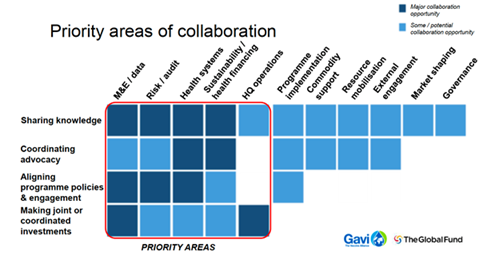Gavi and the Global Fund
Gavi and the Global Fund are the two largest multilateral health financing mechanisms, with closely aligned missions to scale access to health services, fight infectious diseases, and save lives. Both organizations are committed to building resilient and sustainable systems for health and strengthening overall health systems, providing more health products and services to more people, and ensuring access to improved resources. In achieving their respective missions, Gavi and the Global Fund have shown meaningful alignment between their overarching strategic objectives, geographical scope of operations and governance representation.
Both organization carry out their mission by providing grants, many of which benefit from a similar donor base. Grants from Gavi are mainly implemented by national immunization programs. Approximately 80 percent of this support is provided as commodities, which are procured centrally by UNICEF. As of May 2018, 56 countries remain eligible for Gavi support (of which nine are in the process of transition), as based on national income level, while 109 countries are currently eligible for Global Fund support, as based on countries’ income as well as disease burden and other factors. While the Global Fund has a wider geographic scope than Gavi, in part owing to different eligibility criteria, they are concentrated in many of the same countries, particularly in Africa.
In recent years, Gavi and the Global Fund have increasingly coordinated their country-level engagement and investments. This is particularly relevant where countries choose to use the support of both organizations to tackle similar bottlenecks (e.g. to strengthen supply chains) or where both face similar challenges (e.g. low fiduciary management capacity in the same implementing entity). The two organizations have aligned health systems investments in countries such as Burkina Faso, Democratic Republic of Congo, Ethiopia, Gambia, Guinea, Lesotho, Liberia, Malawi, Papua New Guinea, Sierra Leone and Tanzania. This includes joint efforts to strengthen supply chains and data systems.
Building on years of engagement at the program level, the Global Fund and Gavi relocated their headquarters to a common campus in Geneva, in March and June 2018 respectively, signaling their commitment to expand opportunities for engagement. Beyond increasing operational efficiency, the two organizations have highlighted four programmatic areas for further collaboration to increase the effectiveness and impact of their missions. As outlined in the Global Fund 39th Board paper, prepared jointly with Gavi, Enhancing impact and efficiency: Collaboration between Gavi and the Global Fund, these key areas of collaboration include (1) Sharing knowledge, (2) Coordinating policy advocacy, (3) Aligning programmatic policies, and (4) Making joint or coordinated investments, with opportunity areas for each illustrated in the figure below.

Loading resources
